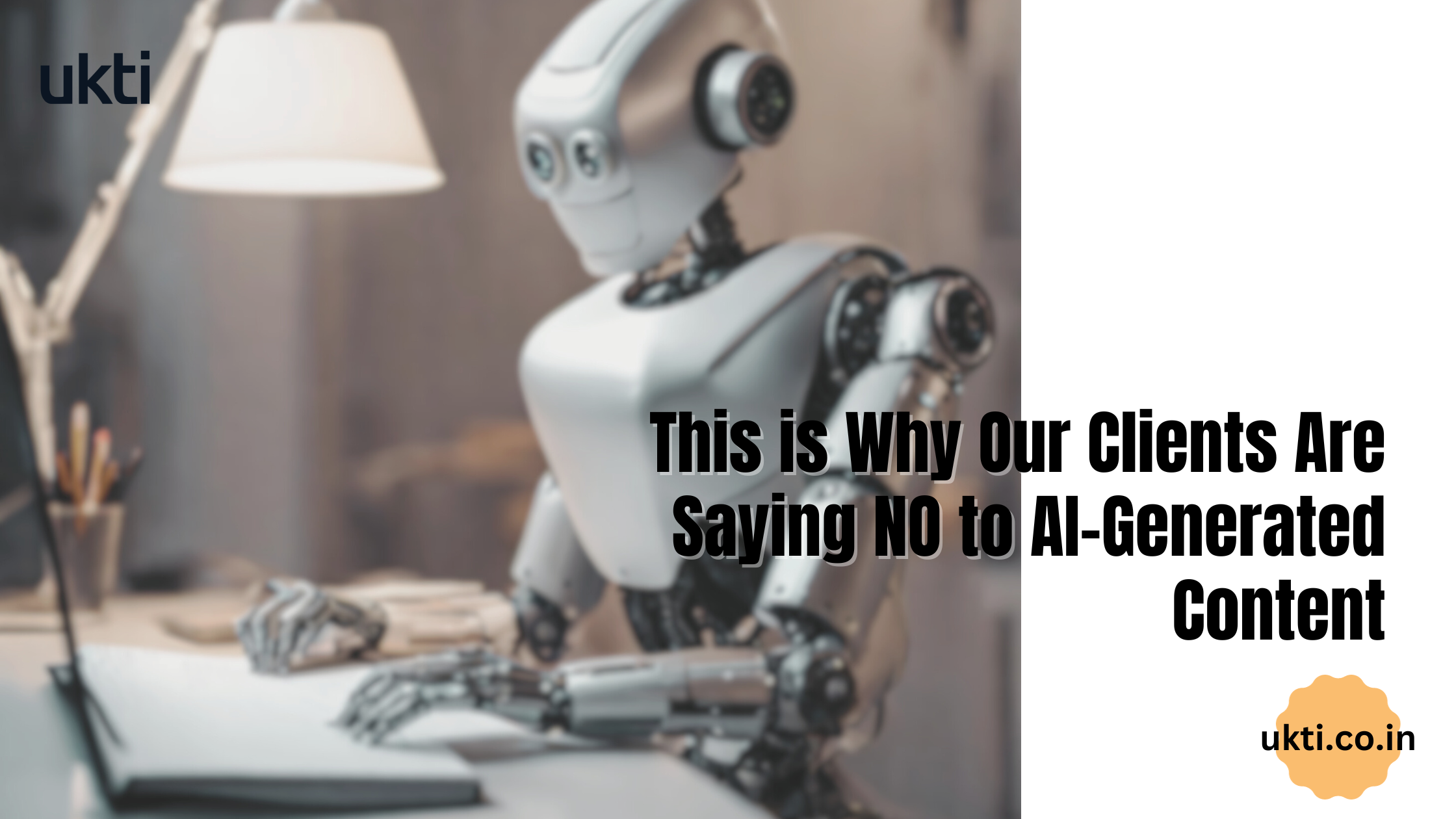Want a quick meal plan for a healthy diet? Or a short presentation for a meeting? You can now turn to your favorite AI model for pretty much anything. Naturally, marketing departments across industries are exploring AI’s prowess in creating content at speed and scale. Sure, AI can do a lot today – just not powerful, authoritative, creative content. And it’s a sentiment that definitively resonates with Ukti’s clients. When it comes to creating content that ranks, persuades, and converts, we’ve seen an active rejection of AI models across our client base.
Let me take you through the ground reality of AI-generated content and our experience at Ukti so far.
Client Perspective: AI Is a No-Go
AI-generated content is yet to gain favor with clients at Ukti. Since ChatGPT came into existence and Google launched Bard, businesses have been studying its capabilities to understand whether it’s something that can be seriously pursued.
Their verdict? No. Our clients have made it clear where they stand with AI-generated content. According to most, human-written content still reigns supreme. But why is that? It’s not only the fact that Ukti delivers valuable content. The aversion stems from more reasons.
Why Are Clients Hesitant About AI?
So, why is AI not being welcomed with open arms in the content writing industry? It’s not because writers fear it’ll replace them. But rather the fact that in all its glory, it still suffers from some key shortcomings. Here’s a look at these.
#1 Google’s Policies Favour Human-Generated Content
As of now, human-written content is Google’s favorite child. Last year, Google shared a content update that specified Google will ensure people see more original, helpful content written by people, for people, in search results. This was enough for businesses looking to leverage content marketing to drop the idea of entertaining AI-generated content. After all, if your content doesn’t rank, it defeats the point of content marketing.
Further, considering Google’s E-E-A-T Policy (which requires your content to showcase experience, expertise, authority and trust to be able to rank high on Google), AI-generated content has another big hurdle to cross. AI can’t, as of now, create content with experience or authority.
#2 AI Content Lacks Creativity
AI platforms like ChatGPT and Bard are simply gathering information based on your prompts. These tools are unable to offer a creative or unique take. Naturally, if your content is simply paraphrasing information already available on the internet, it’s not making any waves.
#3 AI Content Quality Standard Is a Concern
AI-generated content, at times, simply lacks coherence. Since it functions on probabilities and patterns, the article, as a whole, might lack a logical flow of ideas. Another serious issue is plagiarism. Search engine crawlers might catch content that is an exercise in paraphrasing and brings nothing new to the table.
#4 The Human Element Still Remains
A human content writer has to ultimately step in to polish the content generated from an AI model. This could range from inserting the right instance of keyword to avoid keyword stuffing, streamlining the flow of ideas, and fact-checking to editing the content to make it crisper. The human element is still a need. So, if AI can’t do a decent job independently, is it really worthwhile to consider AI-generated content in place of human-written content?
AI-generated content is not as perfect as it should be for it to pose a direct threat to human writers just yet. And so, naturally, relying completely on such an unsteady resource isn’t the brightest idea.
This brings us to an important question.
How Do You Recognise AI-Generated Content?
This is one of the most common questions our sales team is asked by prospects. But, if you’ve been in the business as long as we have, you catch on pretty quickly. You see, AI-generated content has certain telltales.
Here are some common signs of AI-generated content.
#1 Repetition of Words or Phrases
AI doesn’t actually know what it’s writing about. It’s only picking information from varied sources and collating it into a logical sequence- all within the prompt’s scope. As a result, you’ll notice certain phrases or words (probably from the prompt) getting repeated multiple times through the blog.
And so, if you find unnecessary words and an awkward flow, it’s AI-generated content!
#2 Lack of Examination
Another sign of AI-generated content is if the content states facts and doesn’t go beyond to translate them into conclusions. After all, AI is simply paraphrasing, and since analysing content does require a degree of ‘thinking’, AI content won’t include this.
Don’t take my word for it. Here’s ChatGPT’s answer to ‘What do you think of B2B writing?’
As of my last update in September 2021, I don’t have personal opinions or emotions, so I don’t have the capacity to “think” or form opinions in the way humans do. However, I can provide information and insights on a wide range of topics, including B2B writing. If you have specific questions or topics related to B2B writing that you’d like to discuss, feel free to ask!
#3 Inaccurate Content
Human writers make mistakes all the time. But, hear me out. Human-made mistakes aren’t the same as those made by AI. The former might be typos, while the latter includes more graver ones.
A pertinent example is that of AI hallucination. AI chatbots write content by predicting words that suit your prompt. And since it lacks the ability to think or apply the information it’s accessing, the model might go a step further and conjure something out of thin air. This is known as AI hallucination. Since such information has no base, the accuracy of the content naturally suffers.
What About AI Content Detectors?
Why such a roundabout way? Why not simply run the content through an online content detector? Short answer- because they’re unreliable. You have many free tools available in the market that can help you flag content, but these can’t be taken as gospel.
I like to see them as moody teenagers who decide when they want to mess with you. Sometimes, they might highlight your text in that jarring red colour, while other times, you’ll see the same text passing as human-generated content.
And so, once again, it comes down to us, living, breathing beings. If you notice the abovementioned elements through the content, it might be a good idea to probe further.
Final Takeaway
Ever since Open AI unveiled ChatGPT, discussions surrounding AI and its role in content creation have been rife. And just like you, I’ve indulged in my share of trial and error when it comes to what AI can and can’t do.
And this is what I’ve learnt. There’s no denying AI is impressive, at times jaw-dropping. However, its integration into content writing still leaves much to be desired.
The problem is that apart from ultimately requiring a human editor to work on the content, content generators can’t ‘think’, and so, virtues like originality and creativity will always be alien to AI.
That said, AI is powerful, and at the rate at which it’s evolving, we might soon have something better to work with. For now, it’s a waiting game.


1 thought on “This is Why Our Clients Are Saying NO to AI-Generated Content”